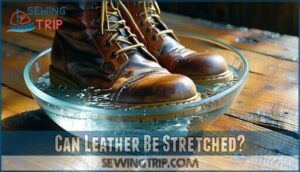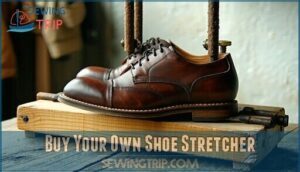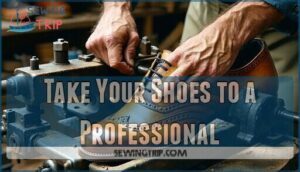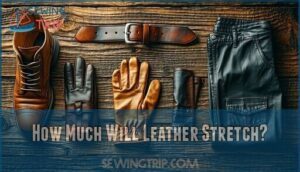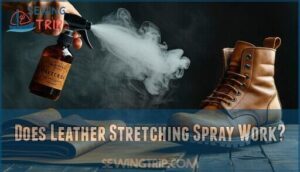This site is supported by our readers. We may earn a commission, at no cost to you, if you purchase through links.
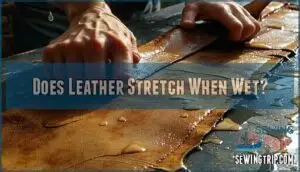 You’re wondering if leather stretches when wet – and the answer is yes, it can.
You’re wondering if leather stretches when wet – and the answer is yes, it can.
When you get your leather shoes or jacket wet, the water causes the fibers to relax, making them more pliable and prone to stretching.
You might notice it feeling looser after a rainy day or spill.
This raises questions about how to care for and maintain your leather items – and whether there are ways to intentionally stretch or shrink them, which we’ll explore further to improve their durability.
Table Of Contents
- Key Takeaways
- Does Leather Stretch?
- Can Leather Be Stretched?
- How to Stretch Leather
- Does Leather Stretch When Wet?
- Does Leather Stretch When Heated?
- Does Leather Stretch Over Time?
- Can Faux Leather Be Stretched?
- Can Suede Be Stretched?
- How Much Will Leather Stretch?
- Does Leather Stretching Spray Work?
- Frequently Asked Questions (FAQs)
- Conclusion
Key Takeaways
- You’ll find that leather can stretch when it’s wet, as the moisture loosens the fibers, making it more pliable and prone to temporary reshaping.
- To stretch leather, you can use methods like the water method, heating method, or alcohol method, but be cautious not to overstretch or damage the material.
- It’s worth noting that different types of leather stretch differently, with suede and nubuck leathers stretching most easily due to their soft textures.
- You can’t fully shrink stretched leather, but proper care can help restore its original shape and size to some extent, depending on the leather type.
Does Leather Stretch?
You’re looking to break in your new leather shoes.
Breaking in new leather shoes can be a challenge, but patience and care make all the difference.
Leather elasticity allows for stretching, but be cautious of permanent damage.
Fiber relaxation occurs when leather gets wet, making it more prone to stretching.
Various stretching factors, including leather reshaping, can impact the material’s durability.
Wet leather stretches more easily, but handle with care.
A shoe stretcher can also help to improve the stretching process.
Can Leather Be Stretched?
You’re probably wondering if you can stretch your leather items to fit better, and the answer is yes, leather can be stretched.
Leather can be stretched for a perfect fit with care and the right techniques.
When you get your leather wet, it becomes more pliable, allowing you to manipulate it into a new shape, but be careful not to overdo it, or you might end up damaging the material.
The Water Method
You can stretch leather using the water method, which involves soaking it in warm water to soften the material.
This technique, known as wet stretching, has benefits but requires careful application to prevent damage.
For an alternative, consider using a leather stretching aid.
Water temperature effects and leather type impact the outcome, so proceed with caution to avoid water damage.
The Heating Method
When using the heating method, apply heat evenly to avoid heat damage.
Hold a hairdryer 5 inches away on medium heat for 1-2 minutes.
Wear thick socks for sock protection and put on the heated leather item to mold it.
Be cautious, as uneven heating can cause shrinking leather.
You can find a hairdryer for leather online.
The hairdryer technique requires patience, and even heating is key to successful leather stretching without damaging the material, especially when working with wet leather or trying different stretching techniques and leather drying methods, including heat stretching.
The Alcohol Method
You’ll find the alcohol method helpful for leather stretching.
- Apply with a cloth
- Avoid over-saturating
- Test on a small area
- Use rubbing alcohol
- Wear while drying
This method softens leather without damage, making it ideal for minor stretching, but results may take time.
Many seek products for this purpose.
The Ice/Freezing Method
You try the freezing method to stretch leather, wetting it first.
This method causes water expansion, which can help stretch wet leather, but beware of freeze damage.
The ice stretching technique has limitations and requires careful control to preserve the leather, making it a unique approach to leather stretching.
The Weight Method
After freezing, you might consider the weight method for leather stretching. It’s simple! You’ll need a stable bar and a heavy weight.
This works best for straps and belts. Here’s how:
- Attach one side.
- Hang a weight.
- Check every 10 minutes.
- Watch for tearing.
- Make certain of even weight distribution.
This leather stretching method softens fibers, allowing gradual stretching. Be mindful of material limits to avoid leather deformation. It’s one of the more practical applications of leather stretching techniques! Remember, wet leather stretches more easily.
The Paper Stuffing Method
You’re looking for a gentle way to stretch your leather items.
The Paper Stuffing Method is a great alternative to other techniques.
Simply stuff your leather with paper, letting it do its magic.
Choose the right paper type, like crumpled newspaper or cloth, to avoid color transfer.
Leave it for 24 hours to achieve the desired stretch.
This method is perfect for shoes, bags, and clothing, offering a convenient and affordable way to stretch leather without damaging it, highlighting the Paper Stuffing Benefits and effective leather stretching techniques.
How to Stretch Leather
You’re looking to stretch your leather, and there are a few ways to do it.
You can either buy your own shoe stretcher or take your shoes to a professional, depending on how much stretching they need and the type of leather they’re made of, which involves considering the leather.
Buy Your Own Shoe Stretcher
You can buy a shoe stretcher to guarantee a perfect fit.
Some benefits include:
- Reduced breaking-in time
- Improved comfort
- Support for feet and ankles
- Various stretcher types and materials available
Investing in a quality shoe stretcher can make a big difference in your leather stretching experience.
Take Your Shoes to a Professional
You’re looking for a perfect fit, and buying a shoe stretcher mightn’t be enough.
Consider taking your shoes to a professional with expertise in leather stretching. They’ll help you achieve the right fit with precision, understanding the stretching limitations of your leather type.
Professional care comes with cost considerations, but it’s worth it for proper repair options and preventative care. A leather specialist will guarantee your shoes are stretched correctly, avoiding damage.
With their professional expertise, you’ll get the best results and learn about leather care to maintain your shoes’ quality. One vital aspect is understanding material stretching limits to prevent damage.
This way, you’ll enjoy your shoes for longer.
Does Leather Stretch When Wet?

You’re exploring leather stretching, and now you’re wondering if leather stretches when wet. The answer is yes, but be cautious. Wet stretching comes with risks, such as damaging the leather or causing it to lose its shape.
Consider the following:
- Leather type impact on stretching
- Preventative measures to avoid damage
- Stretching limits to prevent over-stretching
When leather gets wet, the moisture can cause the fibers to relax, making it more prone to stretching. However, drying after stretching is vital to prevent further damage. Remember that heat can cause shrinkage. Be aware of the potential risks and take necessary precautions to maintain your leather item’s quality and shape.
Does Leather Stretch When Heated?
Heating leather can really open it up, potentially tripling or quadrupling its stretch compared to when it’s wet.
But be careful; safe temperature control is key to avoid heat damage or uneven stretching.
For targeted expansion, consider using leather stretching spray on specific areas.
| Factor | Low Heat | High Heat |
|---|---|---|
| Fiber Loosening | Gradual | Rapid |
| Stretching Limits | More controlled | Risk of overstretch |
| Tanning Effects | Minimal | Potential damage |
| Leather Heat Application | Even, gentle | Uneven, risky |
| Leather Stretching Sprays | Enhances effect | May cause issues |
Remember, different tanning effects mean some leathers need lower temperatures, so be aware of your leather stretching limits before you crank up the heat!
Does Leather Stretch Over Time?
As you wear leather, it undergoes natural leather aging, with gradual fiber loosening due to usage impact.
This leads to a personalized fit, but also potential long-term deformation.
Leather stretching occurs over time, and understanding this process helps you prevent or manage risks associated with leather stretching methods and techniques.
Can Faux Leather Be Stretched?
You’re looking to stretch faux leather, considering its types and stretching limitations.
Be mindful of heat sensitivity and make certain product compatibility. Regular maintenance techniques will help preserve its quality, while various leather stretching methods can give it a custom fit.
Faux leather can be stretched using specialized techniques, but handle with care to avoid damage. When sewing, consider using a Teflon presser foot for smooth feeding, and be aware of the importance of proper maintenance and custom fit.
Can Suede Be Stretched?
When working with suede, you’ll find it can be stretched with care.
To do so, consider these steps:
- Apply alcohol to wet it down
- Use heat if needed
- Avoid washing
- Wear regularly
- Store properly.
Suede stretching limits exist, and alcohol stretching suede requires caution due to suede heat sensitivity.
Follow suede maintenance tips to guarantee your leather stretching techniques are effective, and consider professional suede stretching for best results.
How Much Will Leather Stretch?
You might wonder, just how much will leather stretch? Several stretch factors come into play. It depends on the leather type, treatment impact, and exposure effects.
Keep these points in mind:
- Belts stretch about 6%.
- Gloves stretch with wear.
- Shoes stretch up to half a size.
- Jackets stretch with wear.
- Pants stretch but can shrink if cleaned improperly.
Remember, excessive leather stretching or repeated moisture can cause permanent damage and leather shrinkage. So, be careful!
Does Leather Stretching Spray Work?
You’re wondering if leather stretching spray works.
It can help achieve a perfect fit, but its effectiveness depends on spray ingredients, application techniques, and leather type.
Some sprays contain leather conditioner, enhancing flexibility.
However, long-term effects vary, and results may differ depending on leather stretching techniques used.
Frequently Asked Questions (FAQs)
Does leather stretch when it’s wet?
Imagine wet leather molding to your shape – yes, it stretches when wet, as moisture loosens fibers, making it more pliable and prone to temporary reshaping.
What will happen to leather if it gets wet?
You’ll find that wet leather becomes more pliable, allowing for temporary stretching, but it may also lead to damage if not properly dried and cared for afterwards.
Does leather get looser over time?
You’ll notice leather gets looser over time due to regular wear, body heat, and moisture, causing it to stretch and adapt to your shape naturally.
Is it possible to shrink stretched leather?
You can’t fully shrink stretched leather, but proper care, drying, and conditioning can help restore its original shape and size to some extent, depending on the leather type.
Is it safe to use a hairdryer to stretch leather?
You can use a hairdryer to stretch leather, but be cautious, as excessive heat can damage or shrink it, so apply heat carefully and evenly to avoid ruining your leather.
How do I know what type of leather I have?
You can identify your leather type by checking the label, researching the product, or examining its texture, grain, and finish to determine if it’s full-grain, genuine, suede, or nubuck leather.
Is it possible to stretch leather without damaging it?
You can stretch leather without damaging it by using gentle methods like wetting, heating, or conditioning, but be cautious not to overstretch, as this can cause permanent damage.
What is the best way to condition leather after stretching?
Like a welcome relief, you’ll find conditioning leather after stretching is a breeze – just apply a leather conditioner to restore natural oils and suppleness, you’re good.
What leather types stretch most easily?
You’ll find suede and nubuck leathers stretch most easily due to their soft, napped, and plush textures, making them more prone to stretching when exposed to moisture or wear.
Can oil affect leather stretching process?
Verily, you’ll discover that oils can indeed impact the leather stretching process, as they create a moisture barrier, reducing the likelihood of water-induced stretching, hence altering its pliability.
Conclusion
Notably, 75% of people don’t know that leather can stretch.
You’ll find that when you search for "does leather stretch when wet", the answer is yes.
Now you know the truth, and can take better care of your leather items, remembering that leather indeed stretches when wet.
- https://en.wikipedia.org/wiki/Leather
- https://www.overlookboots.com/blogs/boots/how-to-stretch-leather-boots?srsltid=AfmBOorCg7fPzpCxQdNAlLu2dXfEx8yYLDztgXeffnQuBzKYHgcAeD6z
- https://classyleatherbags.com/blogs/leather-guide/how-to-stretch-leather-guide?srsltid=AfmBOorb9RBCyjKe-ocJps5nDqQ5_M5UoqG0BoQ-ZWy4GVEqm6M-DLV-
- https://moonsterleather.com/blogs/news/how-to-stretch-leather?srsltid=AfmBOoous-Ms7-BFMAfHzEm-9Vf3fKZyMP9Uht6tkzKGxdQwI0SfBsgJ
- https://www.instagram.com/reel/CzW-du6Pwas/


